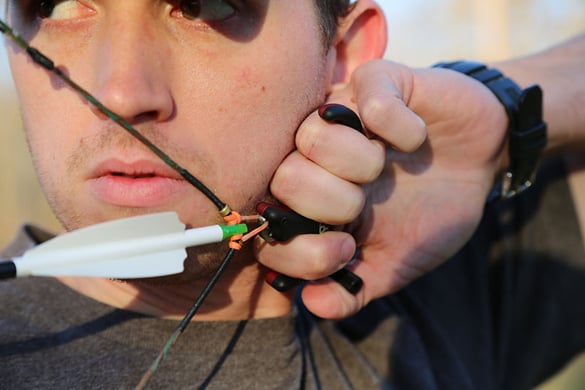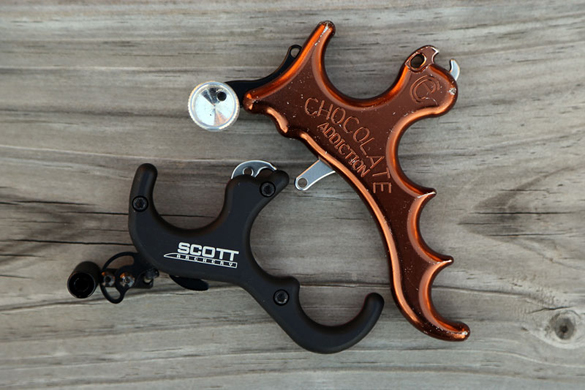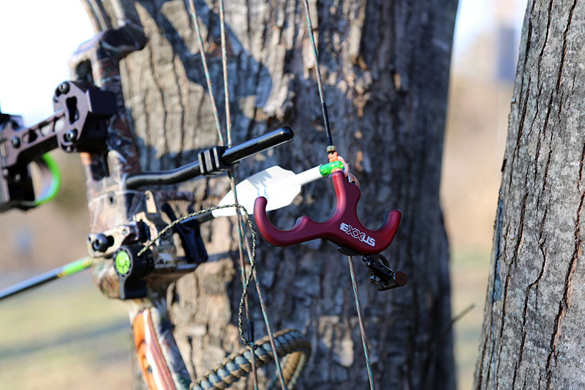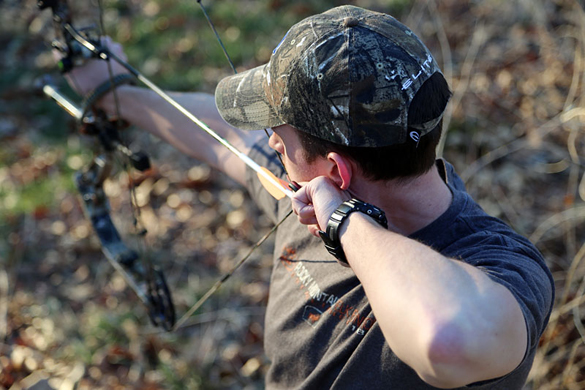LAST UPDATED: May 1st, 2015
Written by Bowhunting.com contributor Mark Huelsing of SoleAdventure.com.
In Part 1 of this series we began to ponder the idea if bowhunters should take a cue from target archers and consider using a handheld release; specifically a thumb-trigger release. Transitioning to a thumb trigger release has helped me improve my shot execution, and assisted in eliminating any sort of target panic or anxiety that I had experienced in the past with standard wrist-strap releases. But before I give you the wrong impression, let me clarify – it is possible to “punch” a thumb-trigger release; and target panic is primarily a problem of the mind, not the hand.
While a good deal of mechanical releases can be manipulated to fire on command, a thumb-style will lesson the tendency to do so to a certain degree. However, the bulk of target panic problems have their origin in the mind.
How to Begin Using a Thumb-Trigger Release
If you are interested in beginning to use a thumb-trigger release (or any new style of release for that matter), the worst thing you can do is grab it and start shooting arrows at the target. Long before you ever attach the release to your bow, you should become familiar with the release’s operation by practicing with a training aid. (Make you’re own trigger device)
You also want to be sure that your release is setup properly before you begin using it. For those that are new to a thumb-trigger release, I recommend setting up the release with little-to-no trigger travel, and mid-to-heavy weight trigger poundage. This is especially true for anyone that has experienced any sort of target panic or shot anxiety – using a thumb trigger with a light breaking weight will do nothing to help your problem.
Once you are comfortable operating the release it is time to move to the bow, but before you start shooting as normal, you should begin by “blank bailing” at the target. It very difficult, if not impossible, for the mind to focus on aiming and release execution at the same time while shooting a bow; and since we are concerned with learning proper release, we need to take aiming out of the shooting equation. Get close to your target, close your eyes, and execute your shot – focusing on applying a proper pull-through release. (How to Blind Bail Practice)
Anytime you try a new release always follow the rule: don’t go too far (away from the target), too light (in trigger sensitivity), too soon (take your time!).
Deciding Which Release Is Right For You
Selecting a release, like choosing most other types of archery equipment, comes down to personal preference. Handheld releases come in a variety of shapes and sizes, so you need to find one that fits your hand well. Moving beyond personal fit, it is important to consider what types of features and adjustability the release has, as well as how easy it is to change settings like trigger travel and trigger weight.
When you’re looking for a new release, be sure to try one that comes with plenty of “adjustability” so that it can be made to fit your specific needs and hand demensions.
For example, a release like the new Exxus from Scott Archery features every sort of user-adjustable setting that you can imagine. Anyone with a set of hex wrenches can quickly and easily adjust the trigger’s position up or down, in or out, as well as rotate it to fit your hand perfectly. The Exxus also makes it easy to adjust the trigger’s travel, and to change springs to adjust the trigger’s poundage. Many other releases that I have tried feature very limited trigger position adjustments, and require that the release’s case be opened to change springs. (choosing a release aid)
Additional Benefits of a Thumb-Trigger Release
We have talked a lot about using a handheld, thumb-trigger releases to improve our shot execution and to help eliminate target panic, but there are several other benefits to using this type of release for bowhunting. I have found that a handheld release provides me with a much more comfortable and repeatable anchor point. A handheld release gives me nice hand-to-jaw contact and has improved my consistency. It is also worth noting that, depending on your anchor, many folks are able to increase their draw length with a handheld release.
Taking the time to improve your shooting technique can only lead to better shot placement and more filled tags.
I also love the fact that a handheld release doesn’t have to be worn while hunting. We’ve all clanked our wrist-strap release on our treestand, or had it catch on our clothes while adding or removing layers of clothing. With a handheld release I keep the release in my pack until I am all setup and then I just clip it onto my d-loop. It is out of the way, but ready to go at a moment’s notice.
A handheld release isn’t a must for every bowhunter, but if you want to improve your consistency and shot execution, I would highly recommend that you pick one up and at least begin experimenting with it. Good luck and shoot straight!









